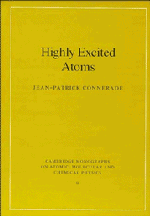Book contents
- Frontmatter
- Contents
- Preface
- 1 Closed shells, sphericity, stability and ‘magic numbers’
- 2 Rydberg states
- 3 Quantum defect theory for bound states
- 4 Atomic f values
- 5 Centrifugal barrier effects
- 6 Autoionisation
- 7 Inner-shell and double-excitation spectra
- 8 K-matrix theory of autoionising resonances
- 9 Atoms in strong laser fields
- 10 Statistical methods and ‘quantum chaology’
- 11 Atomic effects in solids
- 12 Atomic clusters
- References
- Index
3 - Quantum defect theory for bound states
Published online by Cambridge University Press: 19 September 2009
- Frontmatter
- Contents
- Preface
- 1 Closed shells, sphericity, stability and ‘magic numbers’
- 2 Rydberg states
- 3 Quantum defect theory for bound states
- 4 Atomic f values
- 5 Centrifugal barrier effects
- 6 Autoionisation
- 7 Inner-shell and double-excitation spectra
- 8 K-matrix theory of autoionising resonances
- 9 Atoms in strong laser fields
- 10 Statistical methods and ‘quantum chaology’
- 11 Atomic effects in solids
- 12 Atomic clusters
- References
- Index
Summary
Introduction
Quantum defect theory (QDT) was developed by Seaton [111] and his collaborators, from ideas which can be traced to the origins of quantum mechanics, through the work of Hartree and others. They relate to early attempts to extend the Bohr theory to many-electron systems (see e.g. [114]).
In chapter 2, we saw how the quantum defect is defined from a slight modification of the Rydberg formula for H. It is found experimentally to be nearly constant for different series members, especially for unperturbed series in atoms with a compact core. The first task of QDT is to ‘explain’ this fact, and to extract from this empirical observation an appropriate wavefunction, consistent with an effective one-electron Schrödinger equation, such that the quantum defect would turn out to be be nearly constant as the principal quantum number n is changed.
QDT is not an ab initio theory, i.e. it is not an attempt to solve the many-body problem from first principles. Rather, it is a theoreticallybased parametrisation. One seeks a form for the wavefunctions and for their dependence on n; this in turn leads to precise rules for the variation of many other quantities with n because, in quantum mechanics, once the wavefunctions are known, many observable properties of the system become calculable.
The benefits of QDT do not stop there.
- Type
- Chapter
- Information
- Highly Excited Atoms , pp. 79 - 96Publisher: Cambridge University PressPrint publication year: 1998



